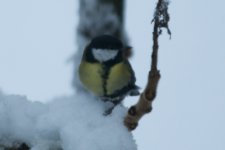Pitvar
Well-known member
Hello all, I know there can be some variation in Blue Tits [witness the dark blue headed pictures on here recently] but today I spotted the attached Great Tit - my feeling is that its just an unusual colouration on its left side but given:
[a] the pronounced white patch at the rear of the cap/nape
the very weak centre stripe
[c] the uniform colour of the upper wing and back feathers - I'd expect to see more blue/grey coverts above the wing bar?
I wondered of there's any chance of it being a hybrid with a blue tit - although I can't find any reference to this and guess the size difference between Blue and Great would make it impossible?
Any comments appreciated. Apologies for the poor shots - it was a dark snowy morning in Cheshire!
[a] the pronounced white patch at the rear of the cap/nape
the very weak centre stripe
[c] the uniform colour of the upper wing and back feathers - I'd expect to see more blue/grey coverts above the wing bar?
I wondered of there's any chance of it being a hybrid with a blue tit - although I can't find any reference to this and guess the size difference between Blue and Great would make it impossible?
Any comments appreciated. Apologies for the poor shots - it was a dark snowy morning in Cheshire!






